First sighting of a new moon
Content last updated: 9th August 2023 18:44 (UTC)When does a Babylonian month begin?
A new month started when a new Moon was observed, this happened every 29 or 30 days, This is because there is just over 29.5 days between each visible new moon. Some months you can observe the Moon after 29 days whilst other times it can be observed after 30 days. Sometimes it might be cloudy so even though the Moon could have been observed, cloud cover obstructed it. In the event that the Moon wasn't observed a new month was started after 30 days anyway.
Controversial Moon Sightings
One argument against dating VAT4956 to the year 588 BC, is whether it was possible to see the crescent Moon in Months I and III. The book First Visibility of the Lunar Crescent and Other Problems in Historical Astronomy by Louay J. Fatoohi (and others) discusses first sightings of lunar crescents. The book lists observations of the new crescent Moon throughout history.
Fatoohi had a very strict criteria for what was included in his list he admits "the final list of acceptable entries, though numbering as many as 209 in total, was unavoidably only a small part of the original material". From this limited number he concluded that "The crescent with the smallest elongation that has been seen by the unaided eye and whose detection did not include the use of optical help nor watching from a high place is 9.1° away from the sun at sunset. The minimum visible topocentric elongation in the Babylonian data is 9.5° - However, modem data show that naked eye observations of lunar crescents with elongations above 9.4° are commonplace".
Fatoohi only used 5 moon sightings from the 6th Century BC, three sightings from VAT4956 and two from 566 BC
Why are there no other young Moon observations?
During the 600 years between 600 BC and 1 BC there are 7,416 lunar months, only 273 months presented an opportunity for a young Moon sighting. For most of these the Moon was less than 14 hours 36 mins old. There are only a couple of opportunities found in all of the publicly available tablets, none of which were observed. The above mentioned book refers to one Babylonian observation in 302 BC that was 15 hours 42 mins old and had an elongation of 9.1°
Fatoohi concludes (using all the available data including recent sightings) that the minimum requirements for a naked eye new crescent sighting is as follows:
- The moon has to be at least 15 hours old
- Minimum Elongation from the Sun is greater than 7.5°
The record for the youngest moon sighting happened 34 years ago at Collins Gap, Tennessee, USA.
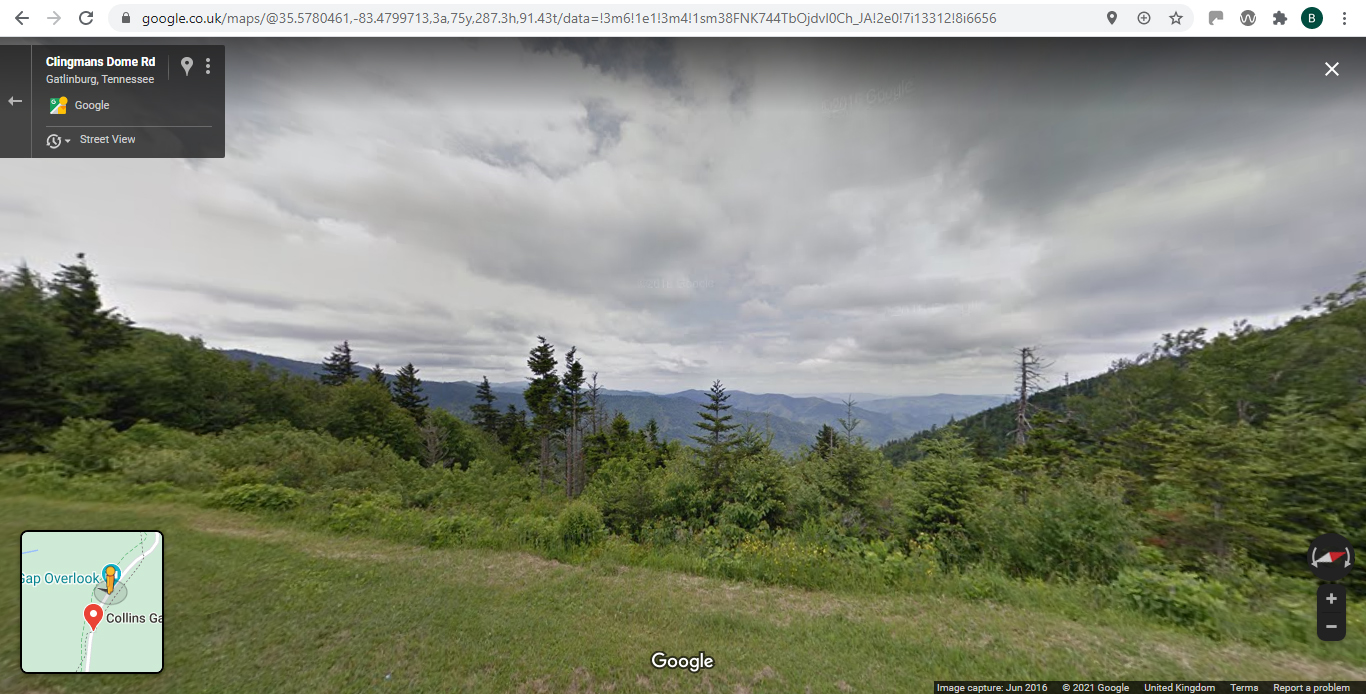
Image credit: Google maps, Street view
The image below is a recreation of the moment the moon became visible at Collins Gap.
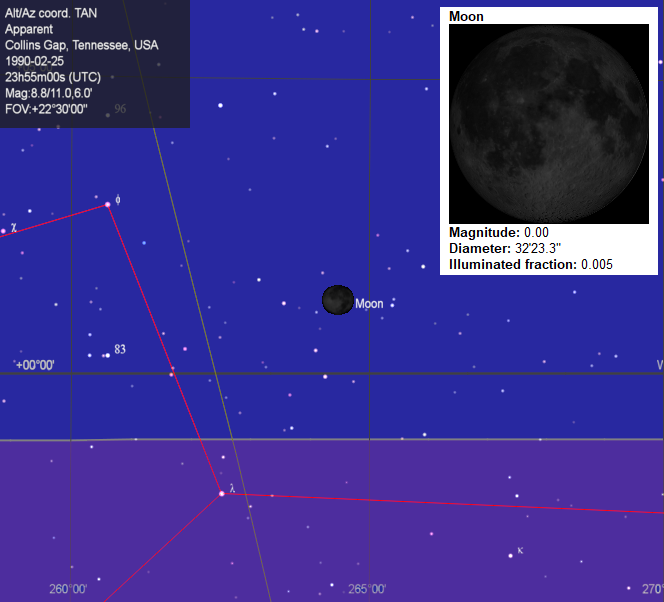
CdC recreation of moon crescent sighting @ Collins Gap, Tennessee, USA
Details of the sighting:
- Observer Name: John Pierce
- First Visibility: 25 February 1990, at 23:55 UT
- Elevation: 1524 m
- Geocentric Age (At First Visibility): 15 hours and 33 minutes
- Elongation (at Best Time): 7.6°
- Topocentric: Altitude 1.140°
This sighting is considered an "extreme example" that doesn't compare with the conditions in ancient Babylon. For this reason one of our critical reviewers dismisses the entire theory that VAT 4956 could be dated to 588 BC, they state "An invisible Moon renders this and the rest of the 588 BCE comparisons invalid as they follow on from this date" (Fact Checking VAT4956.com line 1), Before we dismiss it too, let's compare this sighting with the two controversial months in 588 BC...
You will notice in the CdC image above, that the horizon line (above the purple) is below the 0° normal horizon. This is because the observation was made high up on a mountain (1524m; 5,000ft). At that height, the horizon if unobstructed would be 139.4 Km (86.6 Miles) away, the visible horizon would be below the true horizon.
Is the view from Collins Gap unobstructed?
As you can see from the Google street view image above there are several mountains on the way to the horizon. Do any of these affect the height of the horizon?
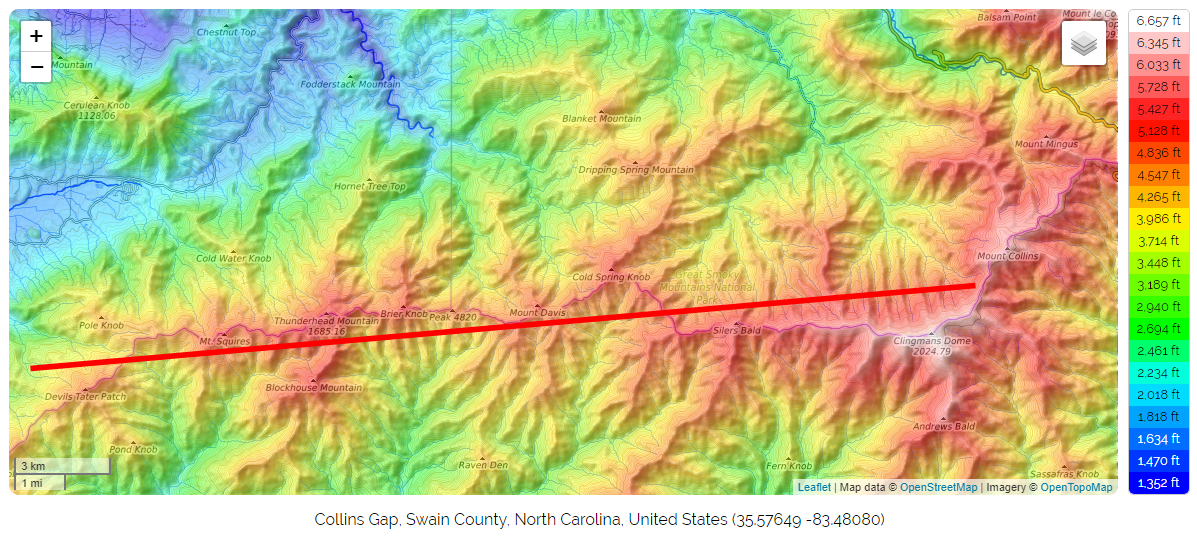
Image credit: Collins Gap - topographic-map.com
The red line indicates the possible line of sight for the observation. How would the mountains along the line affect the horizon?

Image: VAT4956.com scale drawing of the position of mountain interrupting line of sight from Collins Gap, Tennessee, USA
The image above is part of a scale drawing of 139.4 Km line of sight to the horizon. (black line). The red lines indicate the distance from Collins Gap of each obstacle along the line. The degrees listed are the amount each peak is above the apparent horizon. If we assume that the moon sighting missed the peak of Goshen Ridge, and met at a low point by Buckeye Gap, this leaves the ridge at Mount Davis. This would raise the height of the visible horizon by 1.25°. The image below shows this adjustment.
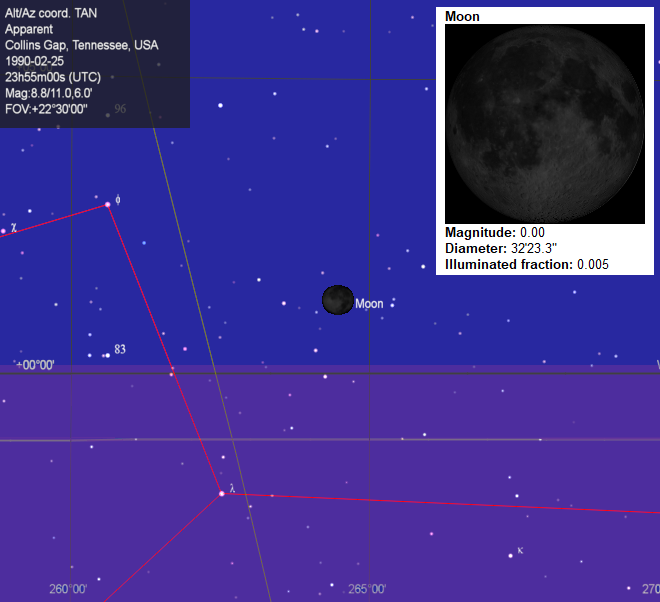
Image credit: Recreation of sighting on 25th Feb 1990 @ Collins Gap, Tennessee, USA, with adjusted horizon.
As you can see that the increase of 1.25° makes the adjusted visible horizon a fraction above the true horizon. Despite this necessary adjustment, are these conditions better than those in ancient Babylon?
How do the conditions in ancient Babylon compare?
According to topographic-map.com the highest points in Babylon itself is 75m (248ft) above sea level, if a modest palace or temple on that site was 15m high the height above sea level could be as much as 90m (295ft). At this height, the visible horizon would be 64 km (24.01 miles) away. There are no natural objects to the west of Babylon that would affect the height of the visible horizon. See image below:
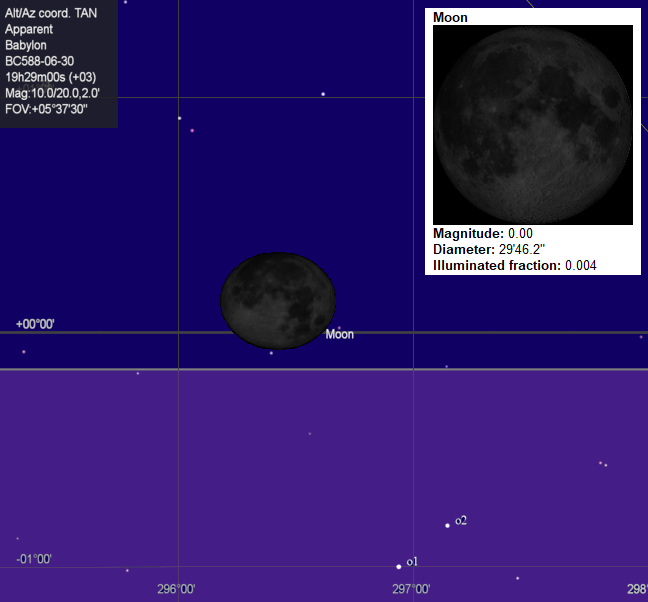
Image credit: CdC Recreation of moon sighting on BC588-06-30 in , with adjusted horizon.
You will notice that the visible horizon is below the true horizon in Babylon. These conditions are arguably better than those at Collins Gap.
How do the moon sightings in 588 BC compare?
2nd May 588 BC
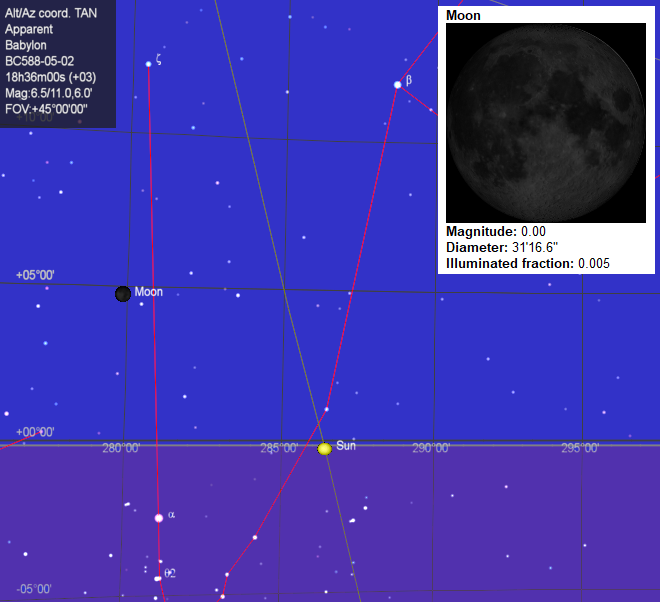
Image credit: CdC Recreation of moon sighting on BC588-05-02 in Babylon, with adjusted horizon.
CdC details: (Sunset/just before moon set)
- Time: 15:36 (UTC) / 16:00 (UTC)
- Sun position: RA: 02h09m42.02s DE:+13°17'03.4" / RA: 02h09m45.72s DE:+13°17'22.7"
- Moon position: RA: 02h42m55.00s DE:+10°45'53.7" / RA: 02h43m47.90s DE:+10°49'21.6"
- Elongation: 8.503° / 8.678° (calculated by VAT4956.com)
- Moon age: 15 hours 3 minutes / 15 hours 27 minutes (source for new moon time)
- ΔT: 18514.50 seconds / 18514.50 seconds
Steve Moshier's Ephemeris Program v5.6 (aa-56) details: (Sunset/just before moon set)
- Time: 15:36 (UTC) / 16:00 (UTC)
- Sun position: R.A. 2h 09m 41.025s Dec. 13d 16' 57.86" / R.A. 2h 09m 44.715s Dec. 13d 17' 17.35"
- Moon position: R.A. 2h 43m 38.451s Dec. 10d 51' 59.41" / R.A. 2h 47m 12.378s Dec. 11d 21' 15.00"
- Elongation: 9.17° / 9.34°
- Moon age: 0.63 = 15 hours 7 minutes (accuracy + 0 - 864 s) / 0.65 = 15 hours 36 minutes (accuracy + 0 - 864 s)
- ΔT: 18792.67 seconds/ 18792.67 seconds
30th June 588 BC
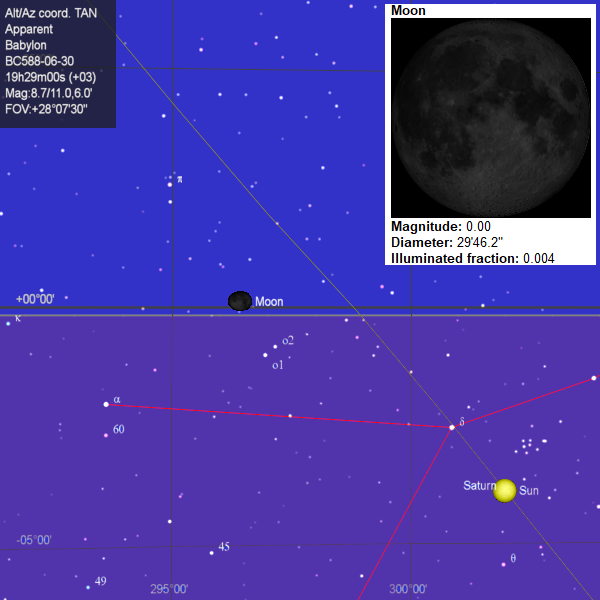
Image credit: CdC Recreation of moon sighting on BC588-06-30 in Babylon, with adjusted horizon.
NASA HORIZONS Web-Interface
- Time: 16:09 (UTC) / 16:29 (UTC)
- Moon position: R.A. 06h 32m 52.73s Declination 21d 55' 54.70" / R.A. 06h 34m 50.46s Declination 22d 06' 52.80"
- Elongation: 6.6851° / 6.8525°
- ΔT: 18175.956835 seconds/ 18175.956215 seconds
CdC details: (Sunset/just before moon set)
- Time: 16:09 (UTC) / 16:29(UTC)
- Sun position: RA: 06h04m24.69s DE:+23°45'38.5" / RA: 06h04m28.19s DE:+23°45'37.9"
- Moon position: RA: 06h32m23.10s DE:+21°48'46.1" / RA: 06h33m10.55s DE:+21°47'37.7"
- Elongation: 6.734° / 6.902° (calculated by VAT4956.com)
- Moon age: 15 hours 37 minutes / 15 hours 57 minutes (source for new moon time)
- ΔT: 18512.04 seconds / 18512.04 seconds
Steve Moshier's Ephemeris Program v5.6 (aa-56) details: (Sunset/just before moon set)
- Time: 16:09 (UTC) / 16:29 (UTC)
- Sun position: R.A. 6h 06m 33.300s Dec. 24d 07' 30.52" / R.A. 6h 04m 26.507s Dec. 23d 45' 34.43"
- Moon position: R.A. 6h 35m 48.025s Declination 22d 18' 55.49" / R.A. 6h 36m 31.721s Declination 22d 19' 11.29"
- Elongation: 7.36° / 7.51°
- Moon age: 0.61 = 14 hours 38 minutes - 14 hours 52 minutes (accuracy + 0 - 864 s) / 0.63 = 15 hours 7 minutes - 15 hours 21 minutes (accuracy + 0 - 864 s)
- ΔT: 18789.68 seconds/ 18789.68 seconds
The information highlighted in green indicate parameters similar to those observed by John Pierce in 1990
Are these observations immediately falsified by the translation?
The information above shows that the the two controversial sightings were possible. In fact, in Fatoohi's conclusion he states - "Although these are the minimum limits of visibility that have been found so far, new observations may show that some of these limits may yet accept slightly lower values. Any such changes, however, are likely to be minimal" - First visibility of the lunar crescent and other problems in historical astronomy, Fathoohi (1998), page 136
A critic (source) of this website points out, that what the translation describes next, that the crescent of the Moon was thick (ka-bar) immediately falsifies these sightings. A thick crescent does not fit with a faint glimmer of a thin new-moon crescent. The best way to get a sense of what is meant is by ka-bar is how it is used on other diaries.
How is ka-bar or ka.bar used in astronomical diaries?
 |  |
| KA | BAR |
The first observation is that the term ka-bar is only used to mean that the crescent is "thick" on VAT 4956, on all other occasions it is associated with rain.
kab-bar "thick" Often abbreviated to kab, once written ka-bar. It is said of rain, probably in regard to raindrops. Abraham J. Sachs & Hermann Hunger (1988) - Astonomical Diaries and Related Texts from Babylonia. Volume I. page 31.
Examples of kab-bar can be seen on diaries -381, -346, -330. The only other use of ka-bar is in diary -372:
[...] first part of the night, the moon was surrounded by a “drawing”; lightning, much wailing thunder, heavy rain so that the sandal was removed, gusty north wind.
Diary -372, obverse, column i, line 7
It is safe to say that using ka-bar to mean a thick crescent is not attested. What else can ka-bar or ka.bar mean? - entries from The Assyrian Dictionary (CAD):
- kabāru: 1. to become fat, heavy, thick, strong. - CAD vol 8, k, page 4.
- kabartu: 1. thickness (ka-bar-tum) - CAD vol 8, k, page 4.
- kaparru: shepherd of low rank (ka.bar) - CAD vol 8, k, page 176.
kaparru: a shepherd of low rank is interesting, what part of ka.bar makes it mean something almost the opposite to the strong, full and fat of kabartu? In this instance ka.bar is short for lu.ka.bar where lu means sheep. A clue might be in a reference quoted by the original translator of VAT 4956.
Also in the astrological texts from Ashurbanopal's library ka-bar comes with this meaning, Virolleaud, L' Astrologie Chaldéenne, 2. Suppl. VIII, 4ff: šumma Sin ina tāmarti-šu ka-bar KI.MIN ku-ri "if the moon is wide or narrow when it appears" - Google translate Neugebauer, Paul Victor - Ein astronomischer Beobachtungstext aus dem 37. Jahre Nebukadnezars II
Does the quote from L' Astrologie Chaldéenne actually say "if the moon is wide or narrow when it appears"?
There is no doubt that ka-bar can mean "thick" but is kurû the opposite i.e "narrow"? This is the Assyrian Dictionary entry for kurû:
The Assyrian Dictionary offers another explanation. In the omen text quoted above "ka-bar KI.MIN ku-ri" the expressions KI.MIN means "ditto" or "similarly", kurû is expressed as a variant of ka-bar. Is supported by kaparru meaning "shepherd of low rank"?
More articles